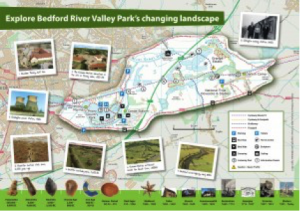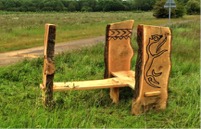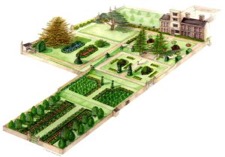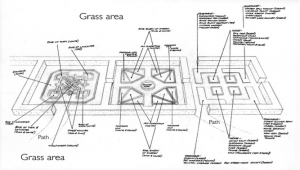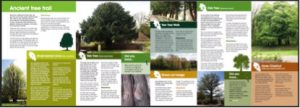Interpretation
Bedford River Valley Park
Catherine worked with Bedford Borough Council to develop an Interpretation Action Plan having reviewed their Heritage Interpretation Strategy. Catherine led on this project working as an associate to inHeritage and took a holistic landscape approach. Our brief was to communicate the whole landscape for each significant period, communicate change through time and to communicate the stories of individual sites while placing them in their wider historic and today’s landscape, and relate these sites to today’s wildlife. A vital element of this project was to communicate to visitors how human land use has created the landscape of the Park that people can see today.
We began with an interpretive planning process where aims and objectives for the BRVP Interpretation Strategy were set. We took the approach that interpretation needed to be inclusive to all visitors. All interpretation met with the Disability Discrimination Act guidelines for countryside and museum interpretation. A variety of interpretive media was targeted to key audiences. A mixture of panels, downloadable PDFs, listening posts and children’s activity sheets provided a comprehensive suite to tell the BRVP story. Catherine was responsible to developing the Plan, helping the client with the Heritage Lottery application (to ‘Our Heritage’) and leading the delivery of the project.
The BRVP Masterplan identified that the project area was extremely rich in historical content and diversity but was also lacking in interpretation and public awareness. Working in partnership with Bedford Borough Council, InHeritage and the Forest of Marston Vale Trust an application was made to the Heritage Lottery to fund a Heritage interpretation project that would tell the story of BRVP from the Palaeolithic age to modern day. The project delivered the following interpretation mediums:
- 12 Large interpretive panels located throughout the project area and content included Medieval Newnham Priory, late Saxon to Norman times, Willington Medieval Settlement, Cambridge to Oxford Railway Line, Priory Roman Villa, Mesolithic to Roman Britain landscapes and the Priory Power Station
- A3 Leaflet introducing the heritage of BRVP and highlighting areas of interest with an annotated map
Map from the BRVP Changing Landscape Leaflet
- New website with engaging we pages to host media content
- Portable BRVP Heritage Exhibition Unit that will be located at key venues within and surrounding BRVP
- Downloadable children’s activity sheets
- Listening posts that tell the story of BRVP’s post war heritage
- BRVP Geocache trail that takes cachers around BRVP to help demonstrate the different landscapes and heritage contained within the 3.5 square miles that make up BRVP
- Community liaison with schools/college, local Archaeology Workshops and other volunteer groups to engage them and develop ideas for the interpretation content
- Railway Sculpture in the form of a cast train wheel with verses from AL Rowse’s poem ‘In the Train to Cambridge’ and is located at former Church End railway crossing in Willington
- Carved bench located within Octagon Woods which is an area rich in Neolithic heritage
Canons Ashby Exhibition, Panels & Trails, National Trust
Catherine led on this project working as an associate for inHeritage.
The project – Exhibitions and self-guided trails of the garden, parkland, pump room and church at Canons Ashby. We were invited by the National Trust property manager to develop three exhibitions and two self-guided trails to interpret the deer park, gardens, Apple Store, Pump Room and St Mary’s Church at Canons Ashby. Part of the project brief was to use the Apple Store to interpret the ongoing garden renovation. The target audiences were adult and family visitors to the property, including those wishing to walk around the deer park.
We installed a new welcome panel at the visitor car park and a series of graphic panel displays in the Apple Store, Pump Room and St Mary’s Church. These were split horizontally to communicate the same key messages to adults and children. We created two versions of a self-guided heritage and wildlife trail, one designed for adults and one for children that linked all parts of the estate and covered the whole of the deer park. As part of the brief we drew a bird’s eye view plan of the gardens.
Marwell Gardens
Catherine led on this project for inHeritage who were commissioned by Marwell Zoo to develop a series of welcome and orientation panels, plant ID signs and a tree trail for the historic gardens at Marwell Hall, home of the Seymour family, and where King Henry VIII was reputed to have visited.
3 panels were installed at key entrance points to the gardens. These have a map with general information about the Hall and gardens. The aim of these panels is to encourage visitors to explore the gardens.
We interpreted the parterre, knot and potager gardens using a ‘bird’s eye’ view approach and designed eye catching plant ID labels as well as an A2 panel based on the drawing below:
We also developed and designed an Ancient Tree Trail to encourage visitors to discover Marwell’s historic side. The Hall is a Grade 1 listed building (over 700 years old) and the Tree Trail offers an experience to follow in the footsteps of Marwell’s residents and explains the ancient trees, their uses and some of their myths.

